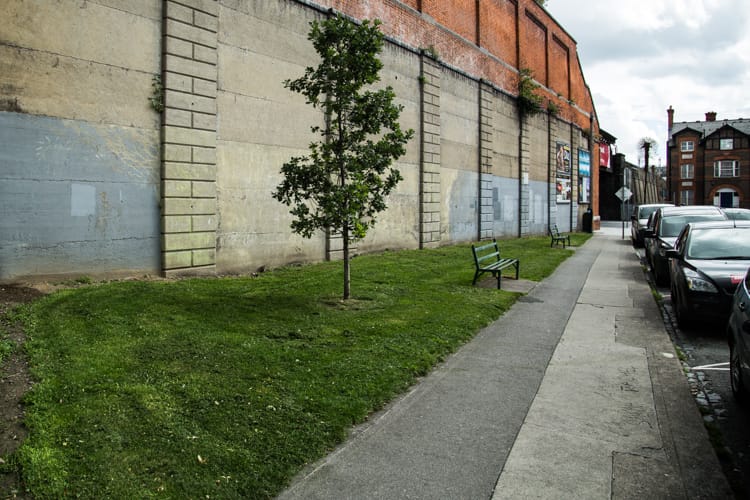What’s the best way to tell area residents about plans for a new asylum shelter nearby?
The government should tell communities directly about plans for new asylum shelters, some activists and politicians say.
A group of residents in Drumcondra are trying to crowd-fund enough money to transform a strip of grass into their dream community pocket park.

Beside Drumcondra Railway Station, there’s a sliver of underused green space. Right now, this scrap of park is bare and backed by the station’s tall grey wall.
As local residents tell it, some people do use the sinewy steel park benches to rest and soak up the street. But other passers-by see the park as a perfect opportunity for public urination, which annoys the community that lives around it.

It wasn’t rumination on the park’s occasional misuse, though, that drove local residents to act and push for a new “pocket park” here.
“Mostly, it is an underutilised opportunity,” says Jen Martin, a resident of St Anne’s Road who is spearheading the effort to redevelop the space. “It doesn’t feel very loved.”
That unloved feeling, Martin explains, does not accurately reflect the tight-knit community that surrounds it. Every time she opened the front door, she’d think something needed to be done about the park opposite.
“I talked to my neighbours a little bit and we thought, ‘You know, we actually could do something about that,’” she said.
A pocket park is basically what it sounds like – a small park built on a vacant building site or small irregular pocket of urban land. The main idea is to take advantage of prime, underutilised space in the city.
A good example of a pocket park in Dublin was the Art Tunnel, a gated pocket park that showcased community artwork just beside the Luas tracks in Smithfield. The Art Tunnel was well loved, but uprooted when the owner didn’t renew the lease.
“After two years, when we didn’t get the lease renewed,we decided to go straight away without asking why,” says Sophie Graefin von Maltzan, landscape architect and artist.
Von Maltzan says that she did not want to scare away potential landowners who may be sitting on unused land in the city centre. Convincing them to let their land be used as a temporary park, for little or no money, is hard enough as it is.
“But this is different isn’t it?” says Von Maltzan of the St Anne’s project. “It’s not disused. It’s just, perhaps, underused.”
One admirer of Von Maltzan’s work is Martin.
“I saw the piece of work that Sophie had done – she worked with the whole community on it,” says Martin. “So I thought I’d float the idea and see if she’d help us. She said, ‘Absolutely.’”
The next challenge was to find some money. Martin applied for a grant from the Croke Park Community Fund last January and got it. “I had them plagued asking questions, before I eventually submitted the application,” she says, “I had never done anything like it before.”
The Croke Park grant was enough for Martin formally to hire Von Maltzan, and get the design process underway.
The space is, it has to be said, spatially constrained. It is 40-metres long and only about a metre wide at its thinnest point. It splays steadily from the narrowest point, becoming about 6-metres wide at its thickest point.
Despite its size, Von Maltzan describes the space as a “wonderful opportunity”.
When she set about the design, her main focus was on what the community wanted, she said. She went to a couple of the Iona Residents’ Association Group’s meetings to talk about the potential park. “Everything you see in the drawings are things that came up during meetings.”

They wanted “something that gives it a sense of local identity,” she said, which is why they decided the tall grey walls that border the park will serve as canvasses for local children’s artwork.
“And then they had this idea of this little adventure trail,” says Von Maltzan, with “lots of balancing and natural elements like logs, timber and plants.” Far from a plastic play park, she says.
Play space is an important part of the park, but “it is not a playground,” says Von Maltzan. It is designed to be a gathering place the whole community can enjoy, not just children.
Von Maltzan says she’s impressed with the help the project has received from Dublin City Council.
“Everyone thinks, oh the Corpo ugh, but in my experience, it’s absolutely not true,” she says. “DCC is so approachable when it comes to this sort of community endeavour.”
Local resident Martin agrees. “Siobhan came over to my house at the very outset to talk about what we could do and get us started,” says Martin of Siobhan Maher, the council’s Public Realm Officer. Maher also attended the first community meeting.
“We advised them about some funding streams that might be available, which they have managed to secure,” says Maher.
Martin, acting on Maher’s advice, supplemented her Croke Park Grant money with a €375 Dublin City Council Community Grants Scheme, and received another €500 from KBC’s Bright Ideas Fund.
But even with the extra funding the community is about €1,000 shy of realising the park they have imagined. To try to overcome the shortfall, Martin has created a GoFundMe page.
If they don’t make up the extra money, they still plan to get work started on the park. But the extra pot of cash would help, says Martin. “If we manage to get the extra €1,000, then it will really take on the form of the design plans that we are hoping for.”
As Von Maltzan says, though, the ultimate success of the park will be how often people hang out there. “Because at the end of the day, the quality of the park depends on its usage, that’s how it comes to life. There’s no point in having something beautiful if it’s not going to be used.”